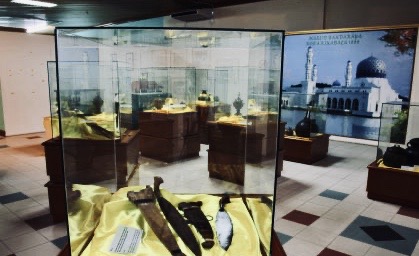Historical Attractions
- SabahGroup
- Apr 9, 2020
- 3 min read
Updated: May 20, 2020
A place that captivates visitors, usually because of its natural or cultural intrinsic or displayed importance, architectural value, natural or designed elegance, and the ability to experience their pleasures and entertainment. Sabah is one of the biggest city in Malaysia that has a rich history of attracting domestic or foreign tourists.
1. MUSEUM ISLAMIC CIVILIZATION
Sabah Museum Islamic Civilization is a collection of all precious historical objects which are related to the Islamic world. This museum is also known as Muzium Tamadun Islam Sabah which is also near to the Sabah State Museum. Islam plays an important role in Sabah as the population of Muslims is around 63.7% in the area. This museum also is a 2 storey building which is located at menteri street in Kota Kinabalu, Sabah. Usually, it will take up to 2 hours for the visit tour. There are also 5 domes which surrounds the museum and it does represent the five pillar of Islam (the foundation of how a Muslim live).
Inside this museum there are several places to visit like the Islamic World Gallery where you can see Islamic artifacts, replicas of the Saidina Uthman sword which is used for the dance performance. There are also boxes and jars which are engraved with Quran verse. Next is betel nut containers which is said to be the most popular spot. It is used as chewing tobacco but added with sirih leaf, lime and gambier paste which all of the items and ingredients are stored in the container. The next spot is the Borneo gallery where it is filled with Sabah Islam antique gallery. It is where plates and cannon engraved with Jawi writing can be found. The last spot is the Islamic costumes where all Muslim cloth, robes, and other accessories which is related to Islam and have a deep meaning behind it. The admission fee is RM 2.00 for Malaysian and RM 15.00 for tourists, so this museum is designed very attractively which is worth going to (Muzium Sabah,2020).
2. PETAGAS WAR MEMORIAL

The Petagas War Memorial is a memorial garden that was built and dedicated to those who became victims in Sabah during the Japanese occupation of the Second World War. The memorial is also situated in the exact position where the victims were executed on 21 January 1944. This memorial was built in 1946 and the first memorial was built in 1948. In the memorial, there are lots of beautiful unique plaques or plates that list the names of those who died and were buried here. Albert Kwok was also one of the leaders who set up an organization and fought against the Japanese invasion. This place is situated 9 km from Kota Kinabalu City and is surrounded by a white metal fence and a total area of 7,800 square meters.

There is also an information board detailing the history of the memorial garden in English and Malay at the main entrance. The four-sided monuments are walking 80 meters from the main entrance. Three of the monuments describe the historical background of the incident, written in three languages, and written on 2-meter high metal plates. On the other side of the memorial is an epitaph that lists the names of the victims. Because most of the victims are Chinese, most of the writings are also in Chinese. There is a 10x 5-meter enclosed field in front of the memorial where the victims were buried. Each year, on 21 January, a memorial service is held to remember the victims who fought and died during the war(MySabah,2012).














Comments